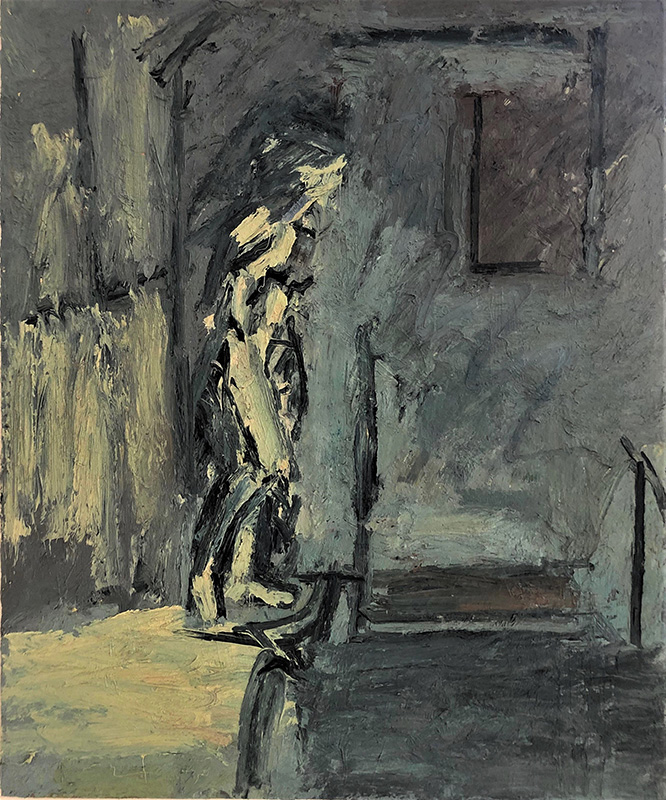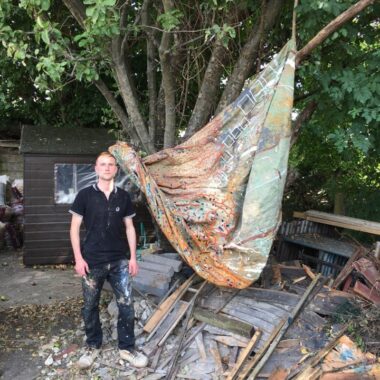My thoughts about why I paint.
The text of the illustrated talk given by Peter Clossick PPLG at Hansard Studio Gallery, 19 Dec 2023

.
In today’s Capitalist economy the world of art and the glitter of celebrity, money, social issues and cultural engineering all reign supreme, rather than depth of emotion. My subjects are ordinary, people who live ordinary and complex lives. They say that history teaches – but that it has no pupils.
I’m a post-war baby boomer from an Irish immigrant background who had his higher education paid for by the state and as a child went to all catholic schools. I like to investigate existence which today is more of a twentieth-century concern than a twenty-first-century one. My early artistic mentors and heroes are David Bomberg and the artists of the so-called London School.

.
I don’t think of an idea and then execute it, my idea arrives through a proprioceptive set of questions about the relatedness to the subject – mainly through gesture – which arrives through sensation, scale, rhythm and bodily process. Expression is represented by feelings rather than illustrated through a narrative storyline or facial expressions. I would classify myself as an expressionist in the sense that was developed in the Modernist era.
This is a quote from Simon Schama “For Catholics, pictures had to be powerful enough to give the beholder a bodily sense of participation in the Passion, so that the boundary between their own persons and that of the Savior, the Virgin, and the apostles all but dissolved. But that was precisely the boundary which Protestantism insisted on respecting, believing the Catholic ardor for physicals, rather than symbolic, communion an act of presumptuous sacrilege.” [1]
I have always been sacrilegious.
.

.
The Critic Nicholas Usherwood wrote that Clossick is one of those painters who found the direction of their art early on, a revelatory moment on Hampstead Heath one evening after a day drawing in a shoe design studio in Mayfair and, I quote, “Looking at a tree and feeling the world, the grass, the people and the wind, I knew I could draw as I designed, in a cliched way. But I wanted to draw as I experienced. Which was different and the existential question then became how do I approach this thinking and feeling, which was a tactile reaching out into haptic contact – this was my first insight.”
Proprioception – Kinaesthesia – the sense of self-movement, force and bodily position – transcends the subject-object divide.
.

I was born in 1948 in central London to a working-class family and at the age of fourteen, I was expelled from Finchley Catholic Grammar School for Moral Turpitude. Attending Life Classes across the road from our council flat at the Working Mens’ College in Camden in the early 1960s, I had a little business at school selling drawings of naked women to the pubescent boys, hence my subsequent downfall into moral turpitude. As a teenager, my early oil canvasses were propped up on the bathroom washbasin in my parent’s flat in place of an easel, which was then my studio.
Being rejected for a Foundation course at Central School of Art when I was sixteen I first studied Shoe Design and worked in a design studio in Mayfair. Winning an RSA bursary for design and several other prizes. One contract I had was from the Bata shoe company which wanted a range of men’s designs for Spring 1969. One of my designs was a woman’s T-Bar on a man’s last, this was before I had even heard of the term “transgender”. Walking along Oxford Street where Bata had their shop I saw the design in the widow. I went in and tried them on and asked the young lady assistant what she thought, – she replied, with a cut to my ego – “I think they’re bloody awful”.
.

.
In between occupations, included labouring on building sites and dealing cards, rolling dice and roulette in Charlie Chesters casino in Soho. I then went to Camberwell & Goldsmiths to study Fine Art and have worked as a lecturer in adult and higher education both full and part-time. At present, I exhibit in galleries from Manchester to London and Cornwall.
I like to feel my emotions, touch and experience the moment. I use tactile oil paint so that the painting falls back into the matter from which it’s made – believing in materialistic painting and dealing with the properties of pigment. Not just optical, but physical objects.
I have a fascination with how I see the world – because it is never the same twice with the cliche, I do not see through thinking but think through seeing. The pre-Socratic Heraclitus said, “I seek, what for me, is the “LOGOS” meaning “the principle” which can change, as I change”. The emphasis is on change, you never step into the same river twice – everything flows systematically.
.

.
Opposites come and go, depending on how you look at things. The beginning and the end of the outline of a circle are the same.
I paint randomly because random is an order we can not understand – our brains implement the order. Lines do not exist in nature except as a product of the brain. True randomness has no memory of what came before. Randomness creates counter-intuitive clusters with no control – our brains control by projecting patterns onto the counter-intuitive clusters.
My belief would be to make an image different enough to bypass the brain’s pattern recognition – to reassess the meaning of an image and make the familiar, unfamiliar. To know that you do not know. Belief is a doubt because you cannot believe something and then know it – you can only believe in what you don’t know. Marcel Duchamp said, “To live is to believe, that’s my belief”.
.

.
My thoughts and beliefs that I hold, create the world that I inhabit. I am trying to reflect on the experience of looking, through the relationship between form and absence. A quote from Anton Chekhov, it’s my role to ask questions not to answer them.
Back in the 1980s when running an Adult Ed class, I bemoaned the fact it was difficult for me to get people to sit in the studio. When a little voice at the back said – I’ll come and sit for you. This was Joan Yardley-Mills, Frank Auerbach’s regular model, J-Y-M for short. Through Jym, who sat for me over the years before she sadly died, I met Frank, who once wrote, “I hope something good comes of your exhibition; this is probably not of any help or relevance but the images in the catalogue work for me… It seems a bit fatuous, but I do feel that you are getting better all the time, which is not true of most of us… For what it is worth, I think the paintings in your new catalogue look (to me) your best…Of course, you are special. I have been impressed by your work….” This was such a nice compliment from someone whom I enormously admire and who has been a big influence on my thinking.
Visual perception is like learning a language – you can begin to understand a language before you can speak it. The act of painting from life, from what is essentially abstract, can never be made concrete without altering its essence. To translate the visible, you do not capture reality but remake it – searching within the limited language of the materials available.
.

.
Space is constantly moving in and out of vision with the physical act of painting integral to the painting itself. I work very physically, probably due to my ABA boxing experience in my youth. We all see things very much in terms of what others have seen, which is why it’s so difficult to “see”. Perception cannot just be reduced to a static photographic image, skilful though it may appear and popular though it is – photography is only one truth.
Quantum theory suggests the universe has no local reality, its surroundings do not completely define objects and lack definitive properties before measurement. When things are not being observed they exist in a quantum state of possibility. Measurement collapses that possibility into something fixed. Everything at the moment is creating the moment, the observer is as important as the observed. The way we observe creates something from being a probability into something fixed and how I observe affects the reality of what I experience. I am all the time trying to haptically measure the subject -which is never the same twice but in a constant state of change.
.

.
I find it strange that from the fixed reality of the world in all its complexity, my reality is constantly changing. It is difficult trying to rationalise an engagement, which I have always found fascinating if not impossible, trying to be truthful with myself. It sort of reminds me of when I was a shoe design student, having spent all my grant money and having only two ingredients left in my room to eat, a box of Weetabix and some eggs, I thought, why not a Weetabix omelette?
It was over-imaginative and certainly not a culinary dish I would recommend to others.
Peter Clossick 2023
.

.
[1] Rembrandt’s Eyes by Simon Schama






